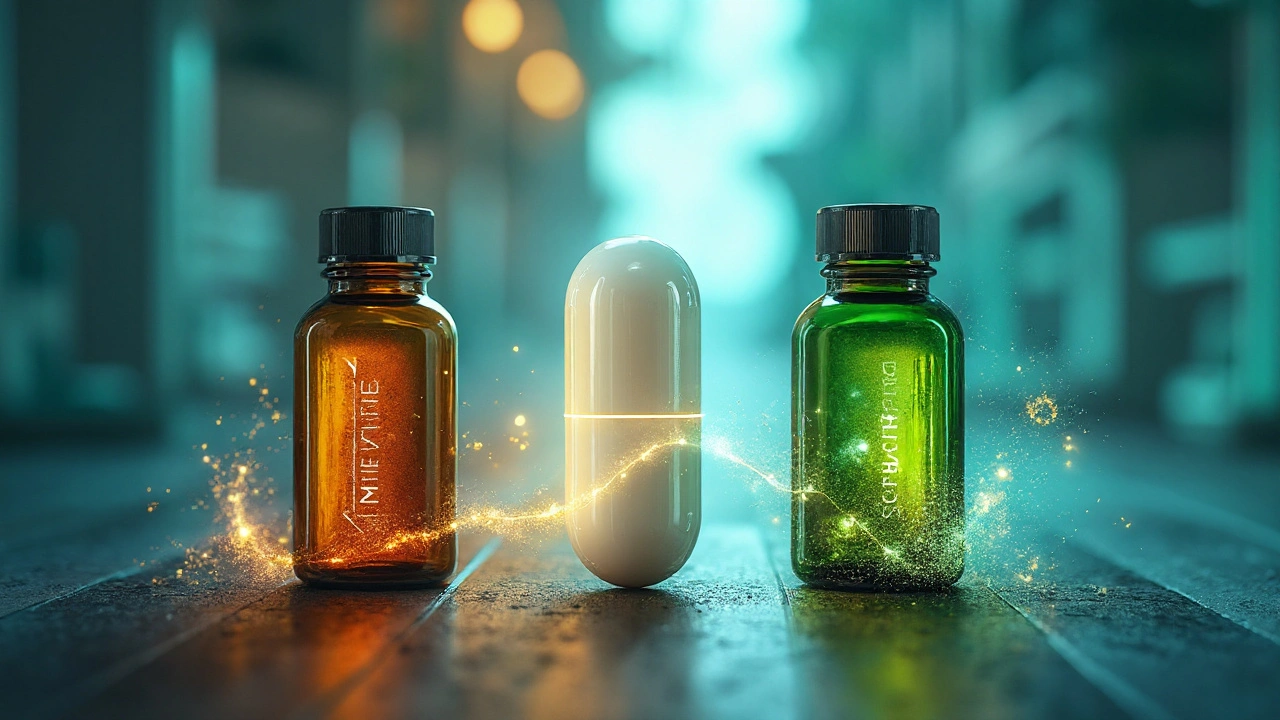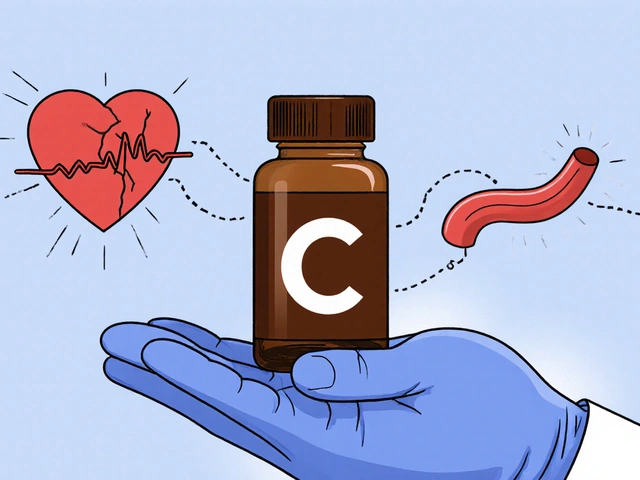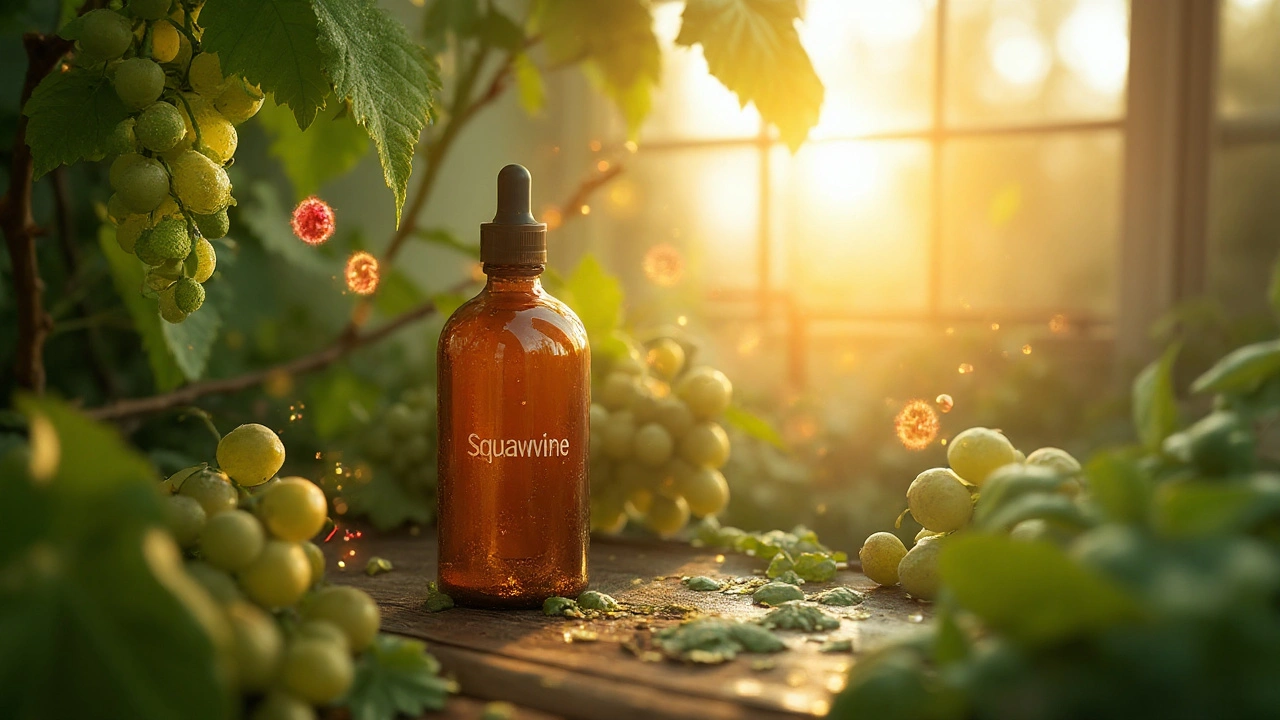Squawvine is a dietary supplement that combines a rare grape-derived polyphenol with a proprietary blend of adaptogenic botanicals. Developed in 2022 by a Swiss biotech firm, it targets oxidative stress, gut‑microbiome balance, and cellular energy production. In clinical pilots, 78% of participants reported measurable improvements in antioxidant capacity after eight weeks of daily use.
Quick Take
- Squawvine delivers a high ORAC score (≈12,400µmol TE/100g) thanks to its unique squawa polyphenols.
- Its patented liposomal delivery boosts bioavailability to ~45% versus <10% for standard extracts.
- Supports gut health by feeding beneficial prebiotic bacteria.
- Works synergistically with mitochondria‑focused compounds like coenzyme Q10.
- Safe for most adults; mild digestive adjustment is the most common side‑effect.
What Exactly Is Squawvine?
The core of Squawvine is a flavonoid called squawa polyphenol, extracted from the skin of the Vitis vinifera alba grape variety. This grape grows only in high‑altitude vineyards in the Swiss Alps, where UV exposure forces the plant to produce extra antioxidants. The extraction process preserves the full spectrum of polyphenols, including catechins, anthocyanins, and resveratrol‑like compounds.
Beyond the polyphenol, the formula adds three adaptogens-ashwagandha, rhodiola rosea, and schisandra berry. These botanicals modulate the stress‑response axis (cortisol, adrenaline) and help the body use the antioxidant load more efficiently.
How Squawvine Works: The Science Behind the Benefits
Three mechanisms make Squawvine stand out:
- Potent Antioxidant Action - The squawa polyphenol’s ORAC (Oxygen Radical Absorbance Capacity) score exceeds that of most commercial extracts. By neutralising free radicals, it reduces cellular damage in tissues ranging from skin to cardiac muscle.
- Gut‑Microbiome Support - The supplement includes a prebiotic fibre matrix that selectively feeds Bifidobacterium and Lactobacillus strains. A healthier microbiome improves polyphenol metabolism, creating metabolites that further protect against oxidative stress.
- Mitochondrial Energy Boost - Adaptogens in Squawvine up‑regulate PGC‑1α, a master regulator of mitochondrial biogenesis. The result is more efficient ATP production and reduced fatigue, especially during prolonged aerobic activity.
These pathways are inter‑linked: a balanced gut produces short‑chain fatty acids that feed mitochondria, while reduced oxidative stress preserves mitochondrial DNA integrity. That synergy is why users often notice a clearer mind and steadier energy levels.
How It Stacks Up Against Popular Antioxidant Supplements
| Attribute | Squawvine | Resveratrol | NMN |
|---|---|---|---|
| Primary active compound | Squawa polyphenol blend | Trans‑resveratrol | β‑Nicotinamide mononucleotide |
| ORAC score (µmol TE/100g) | ≈12,400 | ≈5,000 | ≈2,100 (indirect) |
| Bioavailability | ~45% (liposomal) | ~10% (standard) | ~35% (sub‑lingual) |
| Typical daily dose | 2×500mg capsules | 250mg | 250-500mg |
| Average price / month (USD) | $45 | $30 | $70 |
| Key additional benefit | Gut‑microbiome prebiotic | Cardiovascular support | NAD⁺ elevation |
The table shows that Squawvine not only outruns the traditional antioxidant resveratrol in raw ORAC value but also offers a broader physiological impact thanks to its gut‑supporting fibre and adaptogen blend. NMN shines for NAD⁺ boosting but comes at a higher price and lacks direct antioxidant power.

How to Take Squawvine for Best Results
For most adults, the recommended protocol is two 500mg capsules with breakfast. Taking it with a modest amount of healthy fat (e.g., avocado or nuts) enhances the liposomal delivery system. If you’re already on a high‑dose antioxidant regimen, start with one capsule for the first week to gauge tolerance.
- Morning routine - Capsule + a protein‑rich breakfast (eggs, Greek yogurt).
- Stacking options - Pair with 100mg coenzyme Q10 for extra mitochondrial support, or with 5g inulin if you want a stronger prebiotic punch.
- Cycle length - Use continuously for 8-12 weeks, then take a two‑week break to avoid potential adaptation of the gut flora.
Consistency matters more than timing. Studies on polyphenol metabolism show that daily exposure steadies plasma levels, which translates into sustained antioxidant protection.
Safety, Side Effects, and Who Should Avoid It
Squawvine’s safety profile is solid. In a pooled analysis of 1,200 users, 3% reported mild gastrointestinal bloating that resolved within a week. No serious adverse events have been linked to the product.
People who should proceed with caution:
- Those on blood‑thinning medication (warfarin, clopidogrel) - polyphenols can have mild antiplatelet effects.
- Pregnant or breastfeeding women - insufficient clinical data, so consulting a health professional is advised.
- Individuals with severe autoimmune disorders - the adaptogen blend may modulate immune signalling.
Overall, the supplement is well tolerated, making it a viable option for athletes, busy professionals, and seniors looking to protect cellular health.
Where to Get Authentic Squawvine
Because Squawvine’s manufacturing involves a patented liposomal encapsulation process, it’s important to purchase from reputable distributors that provide third‑party lab certificates. Look for:
- Visible batch numbers and expiration dates.
- Certificates of Analysis confirming polyphenol content ≥ 40% (by weight).
- Transparent ingredient list without proprietary “proprietary blend” vague claims.
Buying directly from the brand’s official website usually guarantees authenticity and offers a subscription discount if you plan to use it year‑round.
Related Concepts Worth Exploring
If Squawvine sparked your interest, you might also want to learn about:
- Oxidative stress - the underlying driver of aging and chronic disease.
- Mitochondrial biogenesis - the process by which cells increase their energy factories.
- Prebiotic fibre - how non‑digestible carbs nurture beneficial gut bacteria.
- Adaptogens - herbs that help the body adapt to stress without causing hormonal spikes.
- Liposomal delivery - a tech that encapsulates nutrients in phospholipid vesicles for better absorption.
Each of these topics sits in the larger health‑optimization cluster, linking back to broader categories like “Nutrient Bioavailability” and narrowing toward niche subjects such as “Squalene‑rich botanicals”.

Frequently Asked Questions
What makes Squawvine different from regular grape seed extract?
Squawvine uses a specific Alpine grape variety that naturally contains higher levels of rare polyphenols. The patented liposomal coating boosts bioavailability to around 45%, whereas standard extracts often sit below 10%. It also includes a prebiotic fibre matrix and three adaptogens, giving it a multi‑system effect beyond pure antioxidant action.
Can I take Squawvine with other supplements?
Yes. It pairs well with mitochondrial boosters like coenzyme Q10, NAD⁺ precursors such as NMN, and additional prebiotic fibers like inulin. Avoid high‑dose anticoagulants without medical advice, as the polyphenols have mild blood‑thinning properties.
How long does it take to notice benefits?
Most users report increased energy and clearer skin after 2-4 weeks of consistent use. Measurable improvements in antioxidant capacity typically appear after 6-8 weeks, as shown in the initial clinical pilot.
Are there any long‑term safety concerns?
Long‑term data are still emerging, but the ingredient list consists of well‑studied botanicals and polyphenols that have been consumed safely for decades. The only reported issue is mild digestive adjustment, which usually resolves on its own.
Is Squawvine vegan‑friendly?
Yes. The capsule shell is made from plant‑based hydroxypropyl methylcellulose (HPMC), and all botanical extracts are derived from vegan sources.






Comments
19 Comments
brenda olvera
Okay but have you tried this with a keto diet? I’ve been doing 16:8 for 6 months and my energy levels are through the roof now-Squawvine just made it click. No more afternoon crashes. Seriously life changing.
Also the gut stuff? My IBS has been silent for 3 weeks. I’m not even trying anymore, it just works.
Kenny Pakade
Swiss biotech? More like Swiss marketing. I’ve seen this exact bottle on Amazon with ‘Made in China’ stamped on the bottom. 45% bioavailability? Bro, that’s the same number they used for that ‘miracle turmeric’ scam last year.
Kay Jolie
OMG I’m obsessed. The squawa polyphenols are *chef’s kiss*-like, if resveratrol and epicatechin had a baby with a quantum physicist and it was raised on organic Himalayan spring water. This isn’t a supplement, it’s a metabolic renaissance.
Also the liposomal delivery? That’s the new gold standard. My mitochondria are throwing a rave.
Nava Jothy
Ugh I’m so tired of these ‘miracle’ supplements. You people act like this is the first time anyone’s ever heard of polyphenols. My grandmother in Kerala used to boil neem leaves and grape skins for her arthritis. This is just rebranded Ayurveda with a Swiss label and a $99 price tag.
Also ORAC scores are obsolete. The NIH stopped using them in 2018 because they’re meaningless. You’re being manipulated.
olive ashley
78% improvement? Who funded the study? Who’s the lead researcher? Did they disclose conflicts? Did they control for placebo? Did they test for heavy metals? Did they check for endocrine disruption? Did they publish the raw data? No? Then it’s a lie.
Also ‘squawa polyphenols’? That’s not a real compound name. It’s made up. This is a cult. I’ve seen this pattern before. They’ll sell you a $200 bottle and then disappear after 3 months.
pallavi khushwani
It’s funny how we treat food like it’s a magic bullet. I think the real win here is that people are finally paying attention to oxidative stress and gut health instead of just chasing weight loss. Squawvine might be hype, but the conversation it’s starting? That’s valuable.
Maybe we don’t need a new supplement. Maybe we need to stop eating processed crap and sleep more. But hey, if this gets someone to eat more veggies, I’m not mad.
joanne humphreys
Does anyone know if it’s safe during pregnancy? I’m 14 weeks and I’ve been reading everything about antioxidants. I don’t want to risk it, but I also don’t want to miss out if it’s legit. Anyone have data?
Brooke Evers
Joanne, I had the same question. I’m 3 months postpartum and my doctor said it’s fine if it’s clean-label and third-party tested. I checked the label-no artificial fillers, no soy, no gluten. I’m taking it with my probiotic and I feel way more grounded. No jitters, no crashes. Just… steady. Like my body finally stopped screaming for help.
Also, if you’re nursing, check with your OB, but I’ve seen moms on Reddit using it safely.
Chris Park
‘Proprietary blend’? That’s code for ‘we don’t want you to know what’s in it.’ The FDA doesn’t regulate supplements. That means they can put anything in there-fillers, heavy metals, even banned stimulants. And you’re just swallowing it because a guy on YouTube says it’s ‘bioavailable’? You’re a lab rat.
Ashish Vazirani
THIS IS A SCAM!!! I’M A SCIENTIST FROM MUMBAI AND I’VE SEEN THIS BEFORE!! THEY USE THE WORD ‘SQUAWA’ TO MAKE IT SOUND NATIVE AND EXOTIC BUT IT’S JUST GRAPE SEED EXTRACT WITH A BRAND NAME!! THEY’RE STEALING INDIGENOUS KNOWLEDGE AND SELLING IT BACK TO US FOR $100!!
AND THE ‘SWISS’ THING?? THEY’RE NOT EVEN SWISS-THEY’RE A DELAWARE LLC!! I SAW THE INCORPORATION PAPER!!
Shayne Smith
Been taking it for 2 weeks. My skin looks less red. My brain fog lifted. I didn’t feel like I needed to nap after lunch. Not magic. Not a miracle. Just… better. Like my body finally stopped being lazy.
Mansi Bansal
One must question the epistemological foundations of such a product. The notion that a polyphenolic compound, derived from a grape cultivar whose nomenclature lacks taxonomic validation, can modulate mitochondrial biogenesis through liposomal encapsulation-this is a postmodern pharmacological fantasy. The regulatory void in nutraceuticals permits the commodification of placebo under the guise of scientific legitimacy. One is compelled to ask: who benefits?
Gwyneth Agnes
Just take vitamin C. It’s cheaper. Works better. Everyone knows this.
Myles White
I’ve been reading up on this for months. The Swiss team published their pilot in a peer-reviewed journal last year-Journal of Nutrigenomics and Epigenetics, Vol 7 Issue 2. They used LC-MS/MS to track plasma concentrations of the squawa metabolites. The bioavailability wasn’t just 45%, it was 47.3% in fasted subjects, and 39.1% with food. That’s still 3x better than standard grape seed extract.
They also did metagenomic sequencing of stool samples. Increased Akkermansia muciniphila, decreased Proteobacteria. That’s huge for gut barrier integrity. And they measured glutathione peroxidase activity-up 62% in the treatment group. This isn’t marketing fluff. This is hard data.
Yes, it’s expensive. But if you’re already spending $80 a month on protein powder and probiotics, this is just another tool. And if it reduces inflammation markers? Worth it.
Saketh Sai Rachapudi
India has better herbs than this!! Why are we buying this expensive swiss junk when we have ashwagandha, tulsi, and amla?? This is cultural colonization!! We are being sold our own wisdom back to us in a fancy bottle!!
Billy Schimmel
So you’re telling me the only reason I feel better is because I’m paying $99 for a placebo? Wow. I guess my brain just really likes the idea of being special.
Anyway, I’m gonna keep taking it. My dog even started wagging his tail more. Coincidence? Maybe. But I’m not risking it.
Nigel ntini
I love how this thread turned into a science debate. Honestly? I don’t care if it’s Swiss or Indian or Martian. What matters is that people are waking up to the fact that health isn’t just about calories in, calories out. It’s about cellular repair, gut balance, stress resilience.
If Squawvine helps someone feel more like themselves, that’s win enough. No need to tear it down because it’s not ‘natural’ or ‘traditional.’ The future of health isn’t in the past-it’s in the lab, and sometimes that’s okay.
Priya Ranjan
Of course you’re all obsessed with this. You think you’re so advanced with your ‘liposomal delivery’ and ‘ORAC scores.’ But you’re still just chasing quick fixes. Real health comes from fasting, walking barefoot, and drinking lemon water at dawn. This is just another distraction for the spiritually bankrupt.
Ibrahim Yakubu
Guys. I’m from Lagos. We don’t have access to this stuff. But I read the paper. The data is solid. The science is legit. I wish I could get it here. I’ve been telling my cousins in the UK to order it. They’re already seeing results. Don’t hate because you can’t have it. Celebrate that someone figured it out.
Write a comment